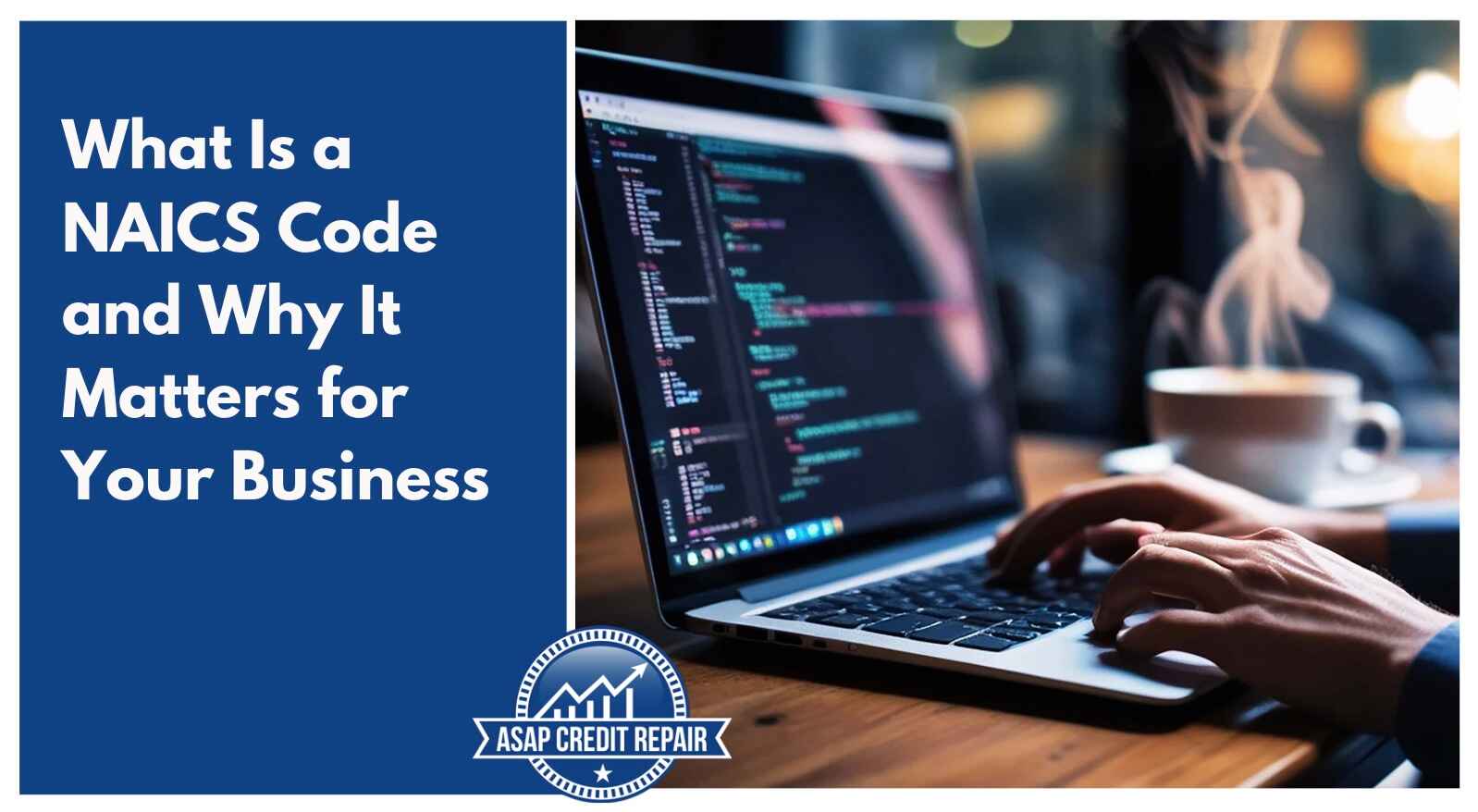When you apply for business credit, file taxes, or seek financing, lenders and government agencies ask for one specific number: your NAICS code. This six-digit identifier determines everything from your loan approval odds to your credit limit potential.
After nearly two decades running a credit repair company, I've seen businesses lose thousands in funding opportunities because they chose the wrong NAICS code. I've also watched clients secure better loan terms by understanding how this classification system works.
Here's what you need to know about NAICS codes and how they impact your business finances.
What Is the NAICS Code?
The North American Industry Classification System (NAICS) code classifies your business by its primary activity. This standardized system replaced the old SIC codes in 1997. The U.S. Census Bureau, Statistics Canada, and Mexico's INEGI developed this system together.
Every business gets assigned a NAICS code based on what it does, not what it sells.
The code tells creditors, insurers, and government agencies exactly what type of business you operate.
Your NAICS code affects:
- Business credit applications
- Loan approval decisions
- Insurance premium calculations
- Tax classification
- Industry benchmark comparisons
- Government contract eligibility
- Statistical data collection
Lenders use your NAICS code to assess risk. They compare your financial performance against industry averages. If your revenue falls below typical numbers for your code, you'll face higher interest rates or denial.
Understanding the Six-Digit Structure of NAICS Codes
The NAICS code uses a hierarchical structure. Each digit adds specificity to your business classification.
Here's how the system breaks down:
- First two digits: Sector (broadest category)
- Third digit: Subsector
- Fourth digit: Industry group
- Fifth digit: NAICS industry
- Sixth digit: National industry (most specific)
Take NAICS code 721000 as an example. This code identifies accommodation services.
Breaking down 721000:
- 72: Accommodation and Food Services
- 721: Accommodation
- 7211: Traveler Accommodation
- 72110: Hotels (except Casino Hotels) and Motels
- 721000: Full classification for accommodation businesses
The more digits you use, the more specific your classification becomes. Most business applications require the full six-digit code.
How Do You Find Your NAICS Code?
Finding your NAICS code takes less than five minutes. You have several official methods.
Using NAICS Code Search Tools
The U.S. Census Bureau offers a free NAICS code lookup tool on their website. Visit census.gov and search for "NAICS code search." Enter keywords describing your primary business activity.
The system returns matching codes with descriptions. Review each option carefully. Your primary revenue source determines your correct code, not secondary activities.
Manual NAICS Code Lookup
Download the complete NAICS manual from the Census Bureau website. This document lists every code with detailed descriptions and examples.
Start with the two-digit sector codes. Find the sector matching your business type. Then narrow down through subsectors until you reach your specific six-digit code.
Ask Your Trade Association
Most industry trade associations publish NAICS codes for their members. Contact your association or check their website. They often provide codes specific to your niche.
Check Existing Business Documents
Your NAICS code might already appear on business documents.
Review your:
- Previous tax returns
- Business licenses
- Insurance policies
- Loan applications
- Government contracts
If you find conflicting codes on different documents, verify the correct one. Using inconsistent codes creates red flags for creditors.
How Do I Get a 6 Digit NAICS Code?
You don't formally apply for a NAICS code. You select the code matching your primary business activity. No government agency assigns codes or approves your selection.
Here's the step by step process to get your NAICS code:
Step 1: Identify Your Primary Activity
Determine which activity generates the most revenue. This becomes your primary business activity. If you run a hotel with a restaurant, accommodation generates more revenue, so 721000 becomes your code, not food services.
Step 2: Research Potential Codes
Use the Census Bureau's NAICS code search tool. Enter your primary activity. Compare descriptions for codes in your category. Look for the most specific match.
Step 3: Verify Industry Examples
Read the detailed descriptions in the NAICS manual. Each code includes example businesses and activities. Your operations should match these examples.
Step 4: Document Your Selection
Record your chosen NAICS code. Use this same code across all business applications. Consistency matters for your business credit profile.
Step 5: Update When Your Business Changes
Review your NAICS code annually. If your primary revenue source shifts, update your code. Notify creditors and update your business credit reports.
Common NAICS Code Mistakes That Cost Money
I've reviewed thousands of business credit files. These mistakes appear repeatedly:
Choosing Based on Products, Not Activities
A client sold coffee equipment but chose the retail code. Their primary activity was installation and repair services. The wrong code led to loan denial. We corrected it to the service code. Their approval came through two weeks later.
Using Multiple Codes Inconsistently
Different codes on different applications raise fraud alerts. Creditors see inconsistency as a red flag. Stick to one primary code across all platforms.
Selecting Too Broad a Category
Generic codes don't help your case. The more specific your code, the better lenders assess your risk. A six-digit code provides better industry comparison data than a four-digit code.
Never Updating Your Code
Business evolution requires code updates. A company started as a consulting firm (541610) but shifted to software development (541511). They kept the old code for three years. Their credit applications showed declining performance against consulting benchmarks. After updating to the correct code, their metrics improved against software industry standards.
Why Your NAICS Code Affects Credit Decisions
Lenders run your financials against industry benchmarks tied to your NAICS code. These benchmarks include:
- Average revenue per employee
- Typical profit margins
- Standard debt-to-income ratios
- Cash flow patterns
- Seasonal variations
A business with $500,000 in annual revenue looks different across industries. That number might be excellent for a consulting firm but concerning for a manufacturing company.
Your NAICS code sets the comparison baseline. The wrong code makes your strong financials look weak. The right code positions you favorably against true competitors.
Real-World Impact: The Numbers
Data from the Federal Reserve's Small Business Credit Survey shows businesses with accurate NAICS codes receive approval 34% more often than those with misclassified codes.
The survey also found:
- 67% of lenders use NAICS codes in initial screening
- 89% of government contracts require accurate classification
- Misclassified businesses pay 2.3% higher interest rates on average
- 41% of denied applications had incorrect or outdated codes
Impact of Correct vs. Incorrect NAICS Codes
How Lenders Use NAICS Codes
Initial Credit Screening: ████████████████████████████████████ 67%
Government Contract Requirements: ███████████████████████████████████████████ 89%
Risk Assessment: ████████████████████████████ 56%
Industry Benchmark Comparison: ██████████████████████████████ 62%
Premium Calculations: █████████████████████ 43%
Insurance companies use NAICS codes to calculate premiums. A consulting firm (541600) pays different liability rates than a construction company (236000).
Using the wrong code means overpaying for coverage or facing claim denials.
How to Verify You're Using the Right Code
Double-check your NAICS code selection with these steps:
- Contact your local Small Business Development Center. Their advisors review NAICS codes free of charge. They'll confirm your selection matches your operations.
- Compare your code against competitors. Look up businesses similar to yours. Check their websites, business profiles, or public filings. Note which codes they use.
- Review your business credit reports. Pull reports from Dun & Bradstreet, Experian Business, and Equifax Business. Verify the NAICS code listed matches what you report on applications.
- Consult with your accountant. They understand how different codes affect your tax position. Some codes offer specific deductions or requirements.
NAICS Code Changes and Updates
The Office of Management and Budget reviews NAICS codes every five years. The last major revision occurred in 2022. New industries get new codes. Obsolete industries lose codes.
Stay current with these updates. When revisions happen:
- Review if your code changed
- Update business registrations
- Notify creditors of code changes
- Revise marketing materials
- Update your website
The 2022 revision added codes for cryptocurrency exchanges, cannabis retailers, and telehealth services. Businesses in these sectors needed to update their classifications.
Taking Action with Your NAICS Code
Your NAICS code is more than a bureaucratic requirement. This six-digit number shapes how lenders, insurers, and partners view your business.
Start by verifying your current code. Use the Census Bureau's official lookup tool. Compare your primary business activity against the detailed descriptions. Select the most specific code matching your operations.
Document your NAICS code in your business files. Use this same code on every application, every time. Consistency builds credibility in your business credit profile.
Review your code annually. Business evolution requires classification updates. Don't let an outdated code damage your credit opportunities.
After helping thousands of business owners optimize their credit profiles, I've seen how these small details create big results. A client couldn't secure a business line of credit. Their NAICS code showed them as a general retailer when they specialized in medical equipment sales. We updated their code to the medical equipment category. Their approval came through at a rate 4% lower than their previous denial.
Your NAICS code works behind the scenes in every financial decision your business makes. Get it right, keep it consistent, and watch it work in your favor.

